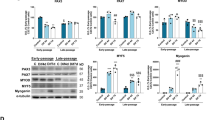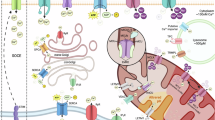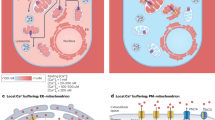Abstract
p66Shc, a redox enzyme that enhances reactive oxygen species (ROS) production by mitochondria, promotes T cell apoptosis. We have addressed the mechanisms regulating p66Shc-dependent apoptosis in T cells exposed to supraphysiological increases in [Ca2+]c. p66Shc expression resulted in profound mitochondrial dysfunction in response to the Ca2+ ionophore A23187, as revealed by dissipation of mitochondrial transmembrane potential, cytochrome c release and decreased ATP levels. p66Shc expression also caused a dramatic alteration in the cells’ Ca2+-handling ability, which resulted in Ca2+ overload after A23187 treatment. The impairment in Ca2+ homeostasis was ROS dependent and caused by defective Ca2+ extrusion due at least in part to decreased plasma membrane ATPase (PMCA) expression. Both effects of p66Shc required Ca2+-dependent serine-36 phosphorylation. The mitochondrial effects of p66Shc were potentiated by but not strictly dependent on the rise in [Ca2+]c. Thus, Ca2+-dependent p66Shc phosphorylation causes both mitochondrial dysfunction and impaired Ca2+ homeostasis, which synergize in promoting T cell apoptosis.
Similar content being viewed by others
Log in or create a free account to read this content
Gain free access to this article, as well as selected content from this journal and more on nature.com
or
Abbreviations
- PTP:
-
permeability transition pore
- ROS:
-
reactive oxygen species
- cPLA2:
-
cytosolic phospholipase A2
- PMCA:
-
plasma membrane ATPase
- GFP:
-
green fluorescent protein
- NF-AT:
-
nuclear factor of activated T cells
- TMRM:
-
tetramethylrhodamine methyl ester
- AICD:
-
activation-induced cell death
References
Ravichandran KS . Signaling via Shc family adapter proteins. Oncogene 2001; 20: 6322–6330.
Migliaccio E, Mele S, Salcini AE, Pelicci G, Lai KM, Superti-Furga G et al. Opposite effects of the p52shc/p46shc and p66shc splicing isoforms on the EGF receptor-MAP kinase-fos signalling pathway. EMBO J 1997; 16: 706–716.
Okada S, Kao AW, Ceresa BP, Blaikie P, Margolis B, Pessin JE . The 66-kDa Shc isoform is a negative regulator of the epidermal growth factor-stimulated mitogen-activated protein kinase pathway. J Biol Chem 1997; 272: 28042–28049.
Pacini S, Pellegrini M, Migliaccio E, Patrussi L, Ulivieri C, Ventura A et al. p66SHC promotes apoptosis and antagonizes mitogenic signaling in T cells. Mol Cell Biol 2004; 24: 1747–1757.
Pellegrini M, Pacini S, Baldari CT . p66SHC: the apoptotic side of Shc proteins. Apoptosis 2005; 10: 13–18.
Migliaccio E, Giorgio M, Mele S, Pelicci G, Reboldi P, Pandolfi PP et al. The p66shc adaptor protein controls oxidative stress response and life span in mammals. Nature 1999; 402: 309–313.
Smith WW, Norton DD, Gorospe M, Jiang H, Nemoto S, Holbrook NJ et al. Phosphorylation of p66Shc and forkhead proteins mediates Aβ toxicity. J Cell Biol 2005; 169: 331–339.
Yang CP, Horwitz SB . Taxol mediates serine phosphorylation of the 66-kDa Shc isoform. Cancer Res 2000; 60: 5171–5178.
Nemoto S, Finkel T . Redox regulation of forkhead proteins through a p66shc-dependent signaling pathway. Science 2002; 295: 2450–2452.
Trinei M, Giorgio M, Cicalese A, Barozzi S, Ventura A, Migliaccio E et al. A p53-p66Shc signalling pathway controls intracellular redox status, levels of oxidation-damaged DNA and oxidative stress-induced apoptosis. Oncogene 2002; 21: 3872–3878.
Napoli C, Martin-Padura I, de Nigris F, Giorgio M, Mansueto G, Somma P et al. Deletion of the p66Shc longevity gene reduces systemic and tissue oxidative stress, vascular cell apoptosis, and early atherogenesis in mice fed a high-fat diet. Proc Natl Acad Sci USA 2003; 100: 2112–2116.
Zaccagnini G, Martelli F, Fasanaro P, Magenta A, Gaetano C, Di Carlo A et al. p66ShcA modulates tissue response to hindlimb ischemia. Circulation 2004; 109: 2917–2923.
Orsini F, Migliaccio E, Moroni M, Contursi C, Raker VA, Piccini D et al. The life span determinant p66Shc localizes to mitochondria where it associates with mitochondrial heat shock protein 70 and regulates trans-membrane potential. J Biol Chem 2004; 279: 25689–25695.
Bernardi P, Krauskopf A, Basso E, Petronilli V, Blalchy-Dyson E, Di Lisa F et al. The mitochondrial permeability transition from in vitro artifact to disease target. FEBS J 2006; 273: 2077–2099.
Giorgio M, Migliaccio E, Orsini F, Paolucci D, Moroni M, Contursi C et al. Electron transfer between cytochrome c and p66(Shc) generates reactive oxygen species that trigger mitochondrial apoptosis. Cell 2005; 122: 221–223.
Ventura A, Luzi L, Pacini S, Baldari CT, Pelicci PG . The p66Shc longevity gene is silenced through epigenetic modifications of an alternative promoter. J Biol Chem 2002; 277: 22370–22376.
Penzo D, Petronilli V, Angelin A, Cusa C, Colonna R, Scorrano L et al. Arachidonic acid released by phospholipase A(2) activation triggers Ca(2+)-dependent apoptosis through the mitochondrial pathway. J Biol Chem 2004; 279: 25219–25225.
Bernardi P . Mitochondrial transport of cations: channels, exchangers and permeability transition. Physiol Rev 1999; 79: 1127–1155.
Orrenius S, Zhivotovsky B, Nicotera P . Regulation of cell death: the calcium-apoptosis link. Nat Rev Mol Cell Biol 2003; 4: 552–565.
Scorrano L, Oakes SA, Opferman JT, Cheng EH, Sorcinelli MD, Pozzan T et al. BAX and BAK regulation of endoplasmic reticulum Ca2+: a control point for apoptosis. Science 2003; 300: 135–139.
Bautista DM, Hoth M, Lewis RS . Enhancement of calcium signalling dynamics and stability by delayed modulation of the plasma-membrane calcium-ATPase in human T cells. J Physiol 2002; 541: 877–894.
Chen J, McLean PA, Neel BG, Okunade G, Shull GE, Wortis HH . CD22 attenuates calcium signaling by potentiating plasma membrane calcium-ATPase activity. Nat Immunol 2004; 5: 651–657.
Fujimoto T . Calcium pump of the plasma membrane is localized in caveolae. J Cell Biol 1993; 120: 1147–1157.
Guerini D, Wang X, Li L, Genazzani A, Carafoli E . Calcineurin controls the expression of isoform 4CII of the plasma membrane Ca(2+) pump in neurons. J Biol Chem 2000; 275: 3706–3712.
Rao A, Luo C, Hogan PG . Transcription factors of the NFAT family: regulation and function. Annu Rev Immunol 1997; 15: 707–747.
Eskes R, Desagher S, Antonsson B, Martinou JC . Bid induces the oligomerization and insertion of Bax into the outer mitochondrial membrane. Mol Cell Biol 2000; 20: 929–935.
Gross A, Jockel J, Wei MC, Korsmeyer SJ . Enforced dimerization of BAX results in its translocation, mitochondrial dysfunction and apoptosis. EMBO J 1998; 17: 3878–3885.
Cai J, Jones DP . Superoxide in apoptosis. Mitochondrial generation triggered by cytochrome c loss. J Biol Chem 1998; 273: 11401–11404.
Scorrano L, Ashiya M, Buttle K, Weiler S, Oakes SA, Mannella CA et al. A distinct pathway remodels mitochondrial cristae and mobilizes cytochrome c during apoptosis. Dev Cell 2002; 2: 55–67.
Soriano ME, Nicolosi L, Bernardi P . Desensitization of the permeability transition pore by cyclosporin A prevents activation of the mitochondrial apoptotic pathway and liver damage by tumor necrosis factor-alpha. J Biol Chem 2004; 279: 36803–36808.
Chiara MD, Bedoya F, Sobrino F . Cyclosporin A inhibits phorbol ester-induced activation of superoxide production in resident mouse peritoneal macrophages. Biochem J 1989; 264: 21–26.
Guerini D, Pan B, Carafoli E . Expression, purification, and characterization of isoform 1 of the plasma membrane Ca2+ pump: focus on calpain sensitivity. J Biol Chem 2003; 278: 38141–38148.
Schwab BL, Guerini D, Didszun C, Bano D, Ferrando-May E, Fava E et al. Cleavage of plasma membrane calcium pumps by caspases: a link between apoptosis and necrosis. Cell Death Differ 2002; 9: 818–831.
Heissmeyer V, Macian F, Im SH, Varma R, Feske S, Venuprasad K et al. Calcineurin imposes T cell unresponsiveness through targeted proteolysis of signaling proteins. Nat Immunol 2004; 5: 255–265.
Bigelow DJ, Squier TC . Redox modulation of cellular signaling and metabolism through reversible oxidation of methionine sensors in calcium regulatory proteins. Biochim Biophys Acta 2005; 1703: 121–123.
Zaidi A, Michaelis ML . Effects of reactive oxygen species on brain synaptic plasma membrane Ca(2+)-ATPase. Free Radic Biol Med 1999; 27: 810–821.
Plyte S, Boncristiano M, Fattori E, Galvagni F, Rossi Paccani S, Majolini MB et al. Identification and characterization of a novel nuclear factor of activated T-cells-1 isoform expressed in mouse brain. J Biol Chem 2001; 276: 14350–14358.
Ghittoni R, Patrussi L, Pirozzi K, Pellegrini M, Lazzerini PE, Capecchi PL et al. Simvastatin inhibits T-cell activation by selectively impairing the function of Ras superfamily GTPases. FASEB J 2005; 19: 605–607.
Liang Y, Yan C, Nylander KD, Schor NF . Early events in Bcl-2-enhanced apoptosis. Apoptosis 2003; 8: 609–611.
Acknowledgements
We thank Sonia Grassini, Eugenio Paccagnini and Luigi Federico Falso for technical assistance; Romano Dallai for useful advice and John L. Telford for critical reading of the manuscript. This work was supported by grants from AIRC (to CTB) and the MIUR (to CTB and PB). The authors have no financial conflicts of interest.
Author information
Authors and Affiliations
Corresponding author
Additional information
Edited by G Melino
Rights and permissions
About this article
Cite this article
Pellegrini, M., Finetti, F., Petronilli, V. et al. p66SHC promotes T cell apoptosis by inducing mitochondrial dysfunction and impaired Ca2+ homeostasis. Cell Death Differ 14, 338–347 (2007). https://doi.org/10.1038/sj.cdd.4401997
Received:
Revised:
Accepted:
Published:
Issue date:
DOI: https://doi.org/10.1038/sj.cdd.4401997
Keywords
This article is cited by
-
A Treg-specific long noncoding RNA maintains immune-metabolic homeostasis in aging liver
Nature Aging (2023)
-
Diallyl trisulfide-induced prostate cancer cell death is associated with Akt/PKB dephosphorylation mediated by P-p66shc
European Journal of Nutrition (2012)
-
p66Shc-dependent apoptosis requires Lck and CamKII activity
Apoptosis (2012)
-
p66Shc—a longevity redox protein in human prostate cancer progression and metastasis
Cancer and Metastasis Reviews (2010)



